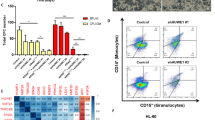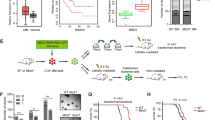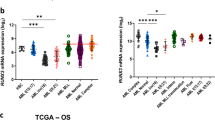Abstract
Acute myeloid leukemia (AML) is frequently linked to epigenetic abnormalities and deregulation of gene transcription, which lead to aberrant cell proliferation and accumulation of undifferentiated precursors. ZRF1, a recently characterized epigenetic factor involved in transcriptional regulation, is highly overexpressed in human AML, but it is not known whether it plays a role in leukemia progression. Here, we demonstrate that ZRF1 depletion decreases cell proliferation, induces apoptosis and enhances cell differentiation in human AML cells. Treatment with retinoic acid (RA), a differentiating agent currently used to treat certain AMLs, leads to a functional switch of ZRF1 from a negative regulator to an activator of differentiation. At the molecular level, ZRF1 controls the RA-regulated gene network through its interaction with the RA receptor α (RARα) and its binding to RA target genes. Our genome-wide expression study reveals that ZRF1 regulates the transcription of nearly half of RA target genes. Consistent with our in vitro observations that ZRF1 regulates proliferation, apoptosis, and differentiation, ZRF1 depletion strongly inhibits leukemia progression in a xenograft mouse model. Finally, ZRF1 knockdown cooperates with RA treatment in leukemia suppression in vivo. Taken together, our data reveal that ZRF1 is a key transcriptional regulator in leukemia progression and suggest that ZRF1 inhibition could be a novel strategy to be explored for AML treatment.
This is a preview of subscription content, access via your institution
Access options
Subscribe to this journal
Receive 50 print issues and online access
$259.00 per year
only $5.18 per issue
Buy this article
- Purchase on Springer Link
- Instant access to full article PDF
Prices may be subject to local taxes which are calculated during checkout





Similar content being viewed by others
References
Nowak D, Stewart D, Koeffler HP . Differentiation therapy of leukemia: 3 decades of development. Blood 2009; 113: 3655–3665.
Deschler B, Lubbert M . Acute myeloid leukemia: epidemiology and etiology. Cancer 2006; 107: 2099–2107.
Tenen DG . Disruption of differentiation in human cancer: AML shows the way. Nat Rev Cancer 2003; 3: 89–101.
Uribesalgo I, Di Croce L . Dynamics of epigenetic modifications in leukemia. Brief Funct Genomics 2011; 10: 18–29.
Wang ZY, Chen Z . Acute promyelocytic leukemia: from highly fatal to highly curable. Blood 2008; 111: 2505–2515.
Duester G . Retinoic acid synthesis and signaling during early organogenesis. Cell 2008; 134: 921–931.
Chanda B, Ditadi A, Iscove NN, Keller G . Retinoic Acid signaling is essential for embryonic hematopoietic stem cell development. Cell 2013; 155: 215–227.
Friedman AD . Transcriptional control of granulocyte and monocyte development. Oncogene 2007; 26: 6816–6828.
Tang XH, Gudas LJ . Retinoids retinoic acid receptors, and cancer. Annu Rev Pathol 2011; 6: 345–364.
Altucci L, Gronemeyer H . The promise of retinoids to fight against cancer. Nat Rev Cancer 2001; 1: 181–193.
Richly H, Rocha-Viegas L, Ribeiro JD, Demajo S, Gundem G, Lopez-Bigas N et al. Transcriptional activation of polycomb-repressed genes by ZRF1. Nature 2010; 468: 1124–1128.
Ribeiro JD, Morey L, Mas A, Gutierrez A, Luis NM, Mejetta S et al. ZRF1 controls oncogene-induced senescence through the INK4-ARF locus. Oncogene 2013; 32: 2161–2168.
Greiner J, Ringhoffer M, Taniguchi M, Hauser T, Schmitt A, Dohner H et al. Characterization of several leukemia-associated antigens inducing humoral immune responses in acute and chronic myeloid leukemia. Int J Cancer 2003; 106: 224–231.
Greiner J, Ringhoffer M, Taniguchi M, Li L, Schmitt A, Shiku H et al. mRNA expression of leukemia-associated antigens in patients with acute myeloid leukemia for the development of specific immunotherapies. Int J Cancer 2004; 108: 704–711.
Siegel S, Wirth S, Schweizer M, Schmitz N, Zeis M . M-phase phosphoprotein 11 is a highly immunogenic tumor antigen in patients with acute myeloid leukemia. Acta Haematol 2012; 127: 193–197.
Schmitt M, Li L, Giannopoulos K, Chen J, Brunner C, Barth T et al. Chronic myeloid leukemia cells express tumor-associated antigens eliciting specific CD8+ T-cell responses and are lacking costimulatory molecules. Exp Hematol 2006; 34: 1709–1719.
Giannopoulos K, Li L, Bojarska-Junak A, Rolinski J, Dmoszynska A, Hus I et al. Expression of RHAMM/CD168 and other tumor-associated antigens in patients with B-cell chronic lymphocytic leukemia. Int J Oncol 2006; 29: 95–103.
Resto VA, Caballero OL, Buta MR, Westra WH, Wu L, Westendorf JM et al. A putative oncogenic role for MPP11 in head and neck squamous cell cancer. Cancer Res 2000; 60: 5529–5535.
Dermime S, Grignani F, Rogaia D, Liberatore C, Marchesi E, Gambacorti-Passerini C . Acute promyelocytic leukaemia cells resistant to retinoic acid show further perturbation of the RAR alpha signal transduction system. Leuk Lymphoma 1995; 16: 289–295.
Oren T, Sher JA, Evans T . Hematopoiesis and retinoids: development and disease. Leuk Lymphoma 2003; 44: 1881–1891.
Lehmann S, Paul C, Torma H . Retinoid receptor expression and its correlation to retinoid sensitivity in non-M3 acute myeloid leukemia blast cells. Clin Cancer Res 2001; 7: 367–373.
Campos EI, Reinberg D . Histones: annotating chromatin. Annu Rev Genet 2009; 43: 559–599.
Uckun FM . Severe combined immunodeficient mouse models of human leukemia. Blood 1996; 88: 1135–1146.
Kastner P, Chan S . Function of RARalpha during the maturation of neutrophils. Oncogene 2001; 20: 7178–7185.
Smith JC, Duchesne MA, Tozzi P, Ethier M, Figeys D . A differential phosphoproteomic analysis of retinoic acid-treated P19 cells. J Proteome Res 2007; 6: 3174–3186.
Uribesalgo I, Buschbeck M, Gutierrez A, Teichmann S, Demajo S, Kuebler B et al. E-box-independent regulation of transcription and differentiation by MYC. Nat Cell Biol 2011; 13: 1443–1449.
Minucci S, Nervi C, Lo Coco F, Pelicci PG . Histone deacetylases: a common molecular target for differentiation treatment of acute myeloid leukemias? Oncogene 2001; 20: 3110–3115.
Jaiswal H, Conz C, Otto H, Wolfle T, Fitzke E, Mayer MP et al. The chaperone network connected to human ribosome-associated complex. Mol Cell Biol 2011; 31: 1160–1173.
Shoji W, Inoue T, Yamamoto T, Obinata M . MIDA1a, protein associated with Id, regulates cell growth. J Biol Chem 1995; 270: 24818–24825.
Anguille S, Van Tendeloo VF, Berneman ZN . Leukemia-associated antigens and their relevance to the immunotherapy of acute myeloid leukemia. Leukemia 2012; 26: 2186–2196.
Zuber J, Rappaport AR, Luo W, Wang E, Chen C, Vaseva AV et al. An integrated approach to dissecting oncogene addiction implicates a Myb-coordinated self-renewal program as essential for leukemia maintenance. Genes Dev 2011; 25: 1628–1640.
Villa R, Pasini D, Gutierrez A, Morey L, Occhionorelli M, Vire E et al. Role of the polycomb repressive complex 2 in acute promyelocytic leukemia. Cancer cell 2007; 11: 513–525.
Huang da W, Sherman BT, Lempicki RA . Bioinformatics enrichment tools: paths toward the comprehensive functional analysis of large gene lists. Nucleic Acids Res 2009; 37: 1–13.
Frith MC, Fu Y, Yu L, Chen JF, Hansen U, Weng Z . Detection of functional DNA motifs via statistical over-representation. Nucleic Acids Res 2004; 32: 1372–1381.
Jolma A, Yan J, Whitington T, Toivonen J, Nitta KR, Rastas P et al. DNA-binding specificities of human transcription factors. Cell 2013; 152: 327–339.
Berge T, Matre V, Brendeford EM, Saether T, Luscher B, Gabrielsen OS . Revisiting a selection of target genes for the hematopoietic transcription factor c-Myb using chromatin immunoprecipitation and c-Myb knockdown. Blood Cells Mol Dis 2007; 39: 278–286.
Acknowledgements
We thank the members of the LDC laboratory for discussions, the CRG Genomic Unit, and VA Raker for help in preparing the manuscript. This work was supported by grants from the Spanish ‘Ministerio de Educación y Ciencia’ (BFU2010-18692), from AGAUR, from ‘Fundació La Marató’ and from by European Commission’s 7th Framework Program 4DCellFate grant number 277899 to LDC; SD was supported by a PFIS fellowship of the ‘Instituto de Salud Carlos III’.
Author information
Authors and Affiliations
Corresponding author
Ethics declarations
Competing interests
The authors declare no conflict of interest.
Additional information
Supplementary Information accompanies this paper on the Oncogene website
Supplementary information
Rights and permissions
About this article
Cite this article
Demajo, S., Uribesalgo, I., Gutiérrez, A. et al. ZRF1 controls the retinoic acid pathway and regulates leukemogenic potential in acute myeloid leukemia. Oncogene 33, 5501–5510 (2014). https://doi.org/10.1038/onc.2013.501
Received:
Revised:
Accepted:
Published:
Issue Date:
DOI: https://doi.org/10.1038/onc.2013.501
Keywords
This article is cited by
-
UV-induced G4 DNA structures recruit ZRF1 which prevents UV-induced senescence
Nature Communications (2023)
-
p113 isoform encoded by CUX1 circular RNA drives tumor progression via facilitating ZRF1/BRD4 transactivation
Molecular Cancer (2021)
-
Intracellular HSP70L1 inhibits human dendritic cell maturation by promoting suppressive H3K27me3 and H2AK119Ub1 histone modifications
Cellular & Molecular Immunology (2020)
-
Silencing of ZRF1 impedes survival of estrogen receptor positive MCF-7 cells and potentiates the effect of curcumin
Tumor Biology (2016)



